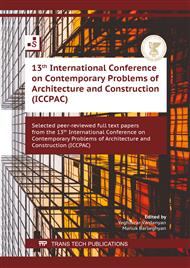[1]
B. Świątkowska, Występowanie chorób azbestozależnych u byłych pracowników zakładów przetwórstwa azbestu w Polsce, Medycyna Pracy 70 (2019) 723-731.
DOI: 10.13075/mp.5893.00890
Google Scholar
[2]
K. Kanecki, I. Kosińska, P.Z. Tyszko, A. Nitsch-Osuch, P. Goryński, G. Zieliński, Asbestosis hospitalizations in Poland (2006–2016): results from the National Hospital, Annals of Agricultural and Environmental Medicine 27 (2020) 284-289.
DOI: 10.26444/aaem/118898
Google Scholar
[3]
M. Krówczyńska, E. Wilk, Asbestos Exposure and the Mesothelioma Incidence in Poland, International Journal of Environmental Research and Public Health 15 (2018).
DOI: 10.3390/ijerph15081741
Google Scholar
[4]
World Health Organization, Asbestos: elimination of asbestos-related diseases, Information on https://www.who.int/news-room/fact-sheets/detail/asbestos-elimination-of-asbestos-related-diseases, (accessed on 24 May 2021).
DOI: 10.1016/j.shaw.2021.12.938
Google Scholar
[5]
J.P. Ramos-Bonilla, M.F. Cely-García, M. Giraldo, P. Comba, B. Terracini, R. Pasetto, D. Marsili, V. Ascoli, B. Lysaniuk, M.C. Rodríguez, A. Mazzeo, R.P. López Panqueva, M. Baldión, D. Cañón, L.G. García-Herreros, B. Pinzón, L.J. Hernández, Y.A. Silva, An asbestos contaminated town in the vicinity of an asbestos-cement facility: The case study of Sibaté, Colombia, Environmental Research 176 (2019).
DOI: 10.1016/j.envres.2019.04.031
Google Scholar
[6]
D. Consonni, S. De Matteis, B. Dallari, A.C. Pesatori, L. Riboldi., C. Mensi, Impact of an asbestos cement factory on mesothelioma incidence in a community in Italy, Environmental Research 183 (2020).
DOI: 10.1016/j.envres.2019.108968
Google Scholar
[7]
E.E. Hellawell, S.J. Hughes, Asbestos contamination on brownfield development sites in the UK, Environmental Research (2020).
DOI: 10.1016/j.envres.2020.110480
Google Scholar
[8]
H.S. Jung, J. Jang, E.K. Park, Y. Cho, J.C. Lee, H. Kim, Changes in concentrations and characteristics of asbestos fibers dispersed from corrugated asbestos cement sheets due to stabilizer treatment, Journal of Environmental Management 285 (2021).
DOI: 10.1016/j.jenvman.2021.112110
Google Scholar
[9]
Law from 19 June 1997 on the prohibition of the use of asbestos-containing products (Dz. U. 1997, 101, poz. 628).
Google Scholar
[10]
Annex to the Resolution No. 39/2010 of the Council of Ministers of 15 March 2010 - Programme for asbestos abatement in Poland 2009-2032.
Google Scholar
[11]
Asbestos datebase. Information on https://bazaazbestowa.gov.pl/en/ (accessed on 24 May 2021).
Google Scholar
[12]
B. Nowakowicz-Dębek, Ł. Wlazło, H. Pawlak, A. Buczaj, A. Chmielowiec-Korzeniowska, M. Bryl, M. Kasela, M. Ossowski, Świadomość ekologiczna społeczeństwa w zakresie zagrożeń związanych z azbestem, Medycyna Ogólna i Nauki o Zdrowiu 21 (2015) 204–207.
DOI: 10.5604/20834543.1152921
Google Scholar
[13]
W. Brzana, A. Buczaj, J. Nowak, D. Nowak, Stężenie włókien azbestu na terenie dzikich wysypisk azbestu, Medycyna Ogólna i Nauki o Zdrowiu 20 (2014) 98–101.
Google Scholar
[14]
M. Ulewicz, W. Liszewski, Influence of public financial support on the process of roof covering replacement and safety of civil structures, System Safety: Human – Technical Facility – Environment – CzOTO 2 (2020) 259-267.
DOI: 10.2478/9788395720437-032
Google Scholar
[15]
Ł. Woźniak, A. Kasztelan, Organizacyjne i ekonomiczne aspekty utylizacji azbestu – studium przypadku gminy Kraśnik, Ekonomia i Środowisko 44 (2013) 104-115.
Google Scholar
[16]
M. Wengierek, Uwarunkowania gospodarki odpadami w zakresie usuwania azbestu i wyrobów zawierających azbest, Zeszyty Naukowe Politechniki Śląskiej. Organizacja i Zarządzanie 89 (2016) 521-537.
Google Scholar
[17]
J. Iwaszko, Making asbestos-cement products safe using heat treatment, Case Studies in Construction Materials 10 (2019).
DOI: 10.1016/j.cscm.2019.e00221
Google Scholar
[18]
Zarząd Województwa Śląskiego, Program usuwania azbestu z terenu województwa śląskiego do roku 2032. Projekt, Katowice, (2011).
Google Scholar


